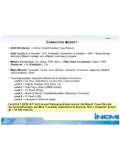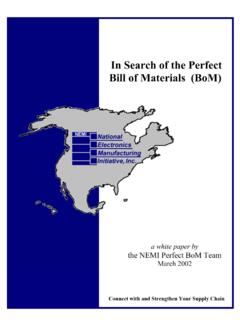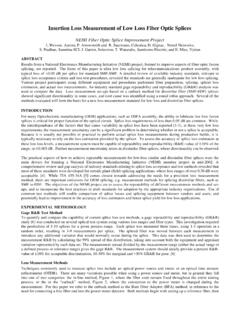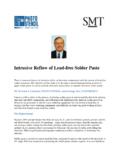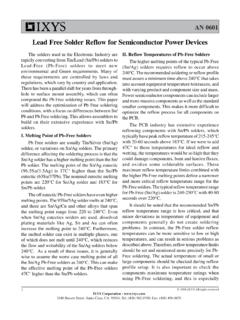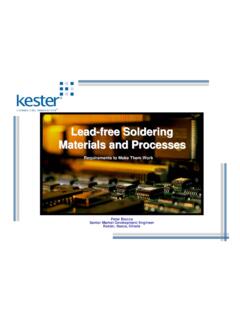Transcription of The Pb-Free BGAs in SnPb Assembly Process Project (The ...
1 The Pb-Free BGAs in SnPb Assembly Process Project (The Backward Assembly Process ) Project Chair: Robert Kinyanjui, Sanmina-SCI Corporation Project Co-Chair: Quyen Chu, JabilIPC/APEX 2008 April 1, 2008 Acknowledgement Acknowledgement OUTLINEOUTLINE Project Scope/Motivation Overview of Project Objectives Experimental design Results SummaryPROJECT MOTIVATIONPROJECT MOTIVATION The coming into effect of the European Union (EU) directive on Reduction of Hazardous Substances (RoHSRoHS) Created supply chain constraints on SnPb components availability especially for the RoHS exempted sector of the industry Has created the need for soldering Pb-Free SnAgCu BGA solder ball terminations in a Sn-Pb soldering Process without yield loss or reliability impactBACKGROUND INFORMATIONBACKGROUND INFORMATION Reflow Process challenges when assembling SAC BGA under the temperature constraints of a conventional SnPb Assembly Process : Peak Temperature has to be within the SnPb Assembly Process (range.)
2 205 through 215C solder joint temperature) Time above liquidus has to be in the range 45-90 seconds Mix of different component sizes (pitch) in a typical Assembly This may result in Ball Collapse issues Non-mixing of the SAC solder balls and SnPb solder paste alloys at the typical SnPb reflow processing conditions (Non-uniform microstructure) may lead to lower solder joint reliabilityOverview of the Project PhasesOverview of the Project Phases Phase 1:To assess the Process parameters for assembling Pb-Free SnAgCu BGAs under the temperature constraints of a conventional tin-lead (SnPb) Assembly Process (A quick overview of The Backward Assembly Process Challenges)1) Studied several Peak reflow temperatures, 205, 210, 215, 220 and 225C2) Stencil, 6mil thick and with 10% reduction in stencil-to-pad opening Phase 2: To Characterize microstructural homogeneity of lead- free BGAs in a SnPb Process Phase 3: To examine the solder joint reliability of Pb-Free Sn-Ag-Cu Ball Grid Array (BGA) Components in Sn-Pb Assembly Process via accelerated thermal cycling test ATC Profile: -40 to 125oC (# of target cycles: 3500) testing Overview of the Project PhasesOverview of the Project PhasesPhase 1.
3 To assess the Process parameters for assembling Pb-Free SnAgCu BGAs under the temperature constraints of a conventional tin-lead (SnPb) Assembly Process (A quick overview of The Backward Assembly Process Challenges)1) Studied several Peak reflow temperatures, 205, 210, 215, 220 and 225C2) Stencil, 6mil thick and with 10% reduction in stencil-to-pad openingObservation At the typical SnPb Assembly Process peak temperatures, we observe non-mixed solder joints which may lead to reduced solder joint reliabilityMixed Alloy solder Joints for a PBGA313 packageImpact of Peak temperature Impact of Peak temperature Reflow @ 225oCPrimary solid: Reflow @ 205oCPrimary solids:(Sn) + + Overview of the Project PhasesOverview of the Project Phases Phase 1: To assess the Process parameters for assembling Pb-Free SnAgCu BGAs under the temperature constraints of a conventional tin-lead (SnPb) Assembly Process (A quick overview of The Backward Assembly Process Challenges)1)Studied several Peak reflow temperatures, 205, 210, 215, 220 and 225C2)Stencil, 6mil thick and with 10% reduction in stencil-to-pad opening Phase 2: To Characterize microstructural homogeneity of lead- free BGAs in a SnPb Process with the following considerations:1)Package size/ball volume, Four different Package sizes2)Reflow Temperature, 210 and 215C3)Time Above Liquidus, 60 ,90, and 120 seconds 4) solder paste volume, 10% reduction and 100% Assembly Process FlowReflow Profile NumberBGA Ball AlloySolder Paste AlloyPeak Temp.
4 (oC)Time Above Liquidus (sec)Stencil Aperture Opening (%)1 (Baseline)1 SnPbSnPb210609021 SnAgCuSnPb210609032 SnAgCuSnPb210909043 SnAgCuSnPb2101209051 SnAgCuSnPb2106010062 SnAgCuSnPb210901007 (Baseline)4 SnAgCuSnAgCu235609085 SnAgCuSnPb2156090 Overview of Phase II Assembly MatrixOverview of Phase II Assembly MatrixEight different Assembly Process flow were generated with FIVE different processing conditions of TALs and Peak TemperaturesFour different packages sizes, 45, 23,, 19 and 8 mm2A total of fifteen boards were assembled for initial inspection and another setof Ninety Eight boards were assembled for Mechanical and ATC testingThe degree of mixing decreases with increasing package (or solder ball volume) CABGA288 Increasing Package SizeEffect of Package Size on the solder Joint Microstructural Effect of Package Size on the solder Joint Microstructural Homogeneity @ Tpeak =210C & TAL = 60 Homogeneity @ Tpeak =210C & TAL = 60 secssecsOverview of the Project PhasesOverview of the Project PhasesTpeak = 210C, TAL = 60secTpeak = 215C, TAL = 60secEffect of Peak Temperature on Degree of MixingEffect of Peak Temperature on Degree of MixingIncreasing the peak temperature by 5oC with TAL = 60 sec, leads to an increased degree of mixing for both PBGA324 and SBGA600 Overview of the Project PhasesOverview of the Project Phases The larger the package/ball volume, the lower the degree of mixing observed CTBGA132 ( Pitch) showed a 100% mixing at 210oC and 60sec time above liquidus Doubling the time above liquidus (from 60sec to 120sec)
5 , increased the degree of mixing (~30% increase in mixing was observed) For the small packages (reduced SAC solder ball volume), increased paste volume corresponds to increased degree of mixing However, for the largest (SBGA600) package no significant change in mixing was observed Increasing the peak temperature from 210oC to 215oC led to a significant increase in the degree of mixing (almost doubled) the extent of mixingOverview of the Phase 2 ResultsOverview of the Phase 2 ResultsMicrostructural Morphology of a Mixed alloy solder Joint refloweMicrostructural Morphology of a Mixed alloy solder Joint reflowed at Low d at Low Peak TemperaturePeak Temperature(Sn) + (Pb) + : starts to melt @ 177 C(Sn) + + : starts to melt @ 217 Cnon-melted SAC at low peak reflow non melted SAC & partiallymelted (Sn) + (Pb) + What is the impact of the segregated phases on the solder joint?
6 ?Overview of the Phase 2 ResultsOverview of the Phase 2 ResultsPackage SideBoard SideOverview of the Project PhasesOverview of the Project Phases Phase 1: To assess the Process parameters for assembling Pb-Free SnAgCu BGAs under the temperature constraints of a conventional tin-lead (SnPb) Assembly ) Studied several Peak reflow temperatures, 205, 210, 215, 220 and 225C Phase 2: To Characterize microstructural homogeneity of lead- free BGAs in a SnPb Process with the following considerations:1)Package size/ball volume2)Reflow Temperature3)Time Above Liquidus 4) solder paste volume Phase 3: To examine the solder joint reliability of Pb-Free Sn-Ag-Cu Ball Grid Array (BGA) Components in Sn-Pb Assembly Process via accelerated thermal cycling test. ATC Profile: -40 to 125oC (for 3500 cycles) testingHow does each of the factors above affect the solder joint reliability (SJR) assembled in a backward reflow Process ?
7 EXPERIMENTAL DESIGNNote: Pb-Free BGA ball alloy: SAC405 SnPb components of each type were used for baseline run SBGA600 PBGA324 CABGA288 CTBGA132 Overview of Components CharacteristicsOverview of Components CharacteristicsFour different package sizes (Pitch) were selected: Assembly Process FlowBGA Ball AlloySolder Paste AlloyPeak Temp. ( C)Time Above Liquidus (TAL) (seconds)Stencil Aperture Opening(%)Number of Boards for ATC Testing (Range: -40oC to 125 C)ENIGOSP1(Control)Sn-PbSn-Pb2106090362S n-Ag-CuSn-Pb2106090065Sn-Ag-CuSn-Pb21060 100363Sn-Ag-CuSn-Pb2109090066Sn-Ag-CuSn- Pb21090100064Sn-Ag-CuSn-Pb21012090367(Co ntrol)Sn-Ag-CuSn-Ag-Cu2356090068Sn-Ag-Cu Sn-Pb215609003945 Phase 3 Assembly test matrix for accelerated thermal cycle (ATC) testEight different Assembly Process flow were generated with FIVE different processing conditions of TALs and Peak TemperaturesPopulated Test VehiclePopulated Test Vehicle PCB Dimensions.
8 X x Finish Electroless Nickel Immersion Gold (ENiG) Copper OSP Number of Layers 8 Internal board Layers Tg = 170oC Td = 340oCTest vehicle populated with three of each of the four types of components usedSBGA600 PBGA324 CABGA288 CTBGA132 solder Joint Reliability (SJR) ResultsOptical & SEM images showing the most commonly observed failure mode for the CTBGA132 packageSolder Joint Observed failure ModesIMC LayerThe solder joints are completely open on the package side while the crack is only partial on the package side solder Joint Observed failure ModesOptical images showing the most commonly observed failure mode for the CABGA288 packageThe solder joints are completely open on the package side while the crack is only partial on the package side solder Joint Observed failure ModesThese fractures could not be confirmed by electrical testing during thermal cyclingSEM images showing the most commonly observed joint fractures on the PBGA324 and SBGA6000 packagesNumber of Failed Packages After 3559 ATC testing CyclesPCB FinishOSPENIGOSPOSPOSPENIGOSPENIGOSPOSPO SPA ssembly Process Flow1A1B234A4B5A5B678
9 SBGA6001/189/90/180/180/180/90/180/90/18 4/180/18 PBGA3240/189/90/180/180/180/90/180/90/18 17/180/18 CABGA28818/189/918/1818/1818/189/918/189 /918/1818/180 CTBGA13218/189/918/1818/1818/189/918/189 /99/918/180 NOTABLE OBSERVATIONS:1) All the standard and mixed alloy CTBGA132 and CABGA288 packages failed at the end of the ATC testing2) All mixed alloy, SBGA600 and PBGA324 packages survived at the end of ATC testingA summary of Number of Failed Packages at the end of 3559 CyclesElectrical Testing Results at the End of ATC TestDecreasing Package SizeSUMMARY OF OBSERVATIONSSUMMARY OF OBSERVATIONS The CTBGA132 and the CABGA288 packages showed a significant number of failures across all of the Assembly test conditions, while no failures were recorded for the PBGA324 and SBGA600 packages for the mixed alloy assemblies The following conclusions are drawn from this work: For the smallest, CTBGA132 package, all three TAL conditions had full solder alloys mixing The solder joint reliability of the fully mixed test assemblies for all TALs (= 60, 90, and 120 seconds) exceeds that of Sn-Pb and is at least equal to that of pure SAC For the larger, CABGA288 package, increasing the TAL does not provide complete solder alloy mixing The solder joint reliability of all TALs tested (TAL = 60, 90, and 120 seconds)
10 Is less than that of both pure Sn-Pb and pure SAC The longest TAL condition displayed a better solder joint reliability among the three TAL conditionsSUMMARY OF OBSERVATIONSSUMMARY OF OBSERVATIONS For the two largest packages, PBGA324 and SBGA600, despite lack of complete solder alloy mixing, the solder joint reliability was better than that of either pure Sn-Pb or pure SAC solder joints Full Sn-Pb and SAC solder alloys mixing is not a sufficient condition to guarantee good reliability For small packages with low fatigue life requirements, full solder alloys mixing and homogeneous microstructure is required while for large packages with long fatigue/extended life requirement, full solder alloy mixing is not necessary for acceptable solder joint reliability In general, the OSP-copper had better performance than the ENIG surface finish. However, the failure locations were almost exclusively at the package side of the solder joint and within the bulk solder At this time no microstructural correlation has been identified linking surface finish and improved or reduced reliability Thank YouQuestions

